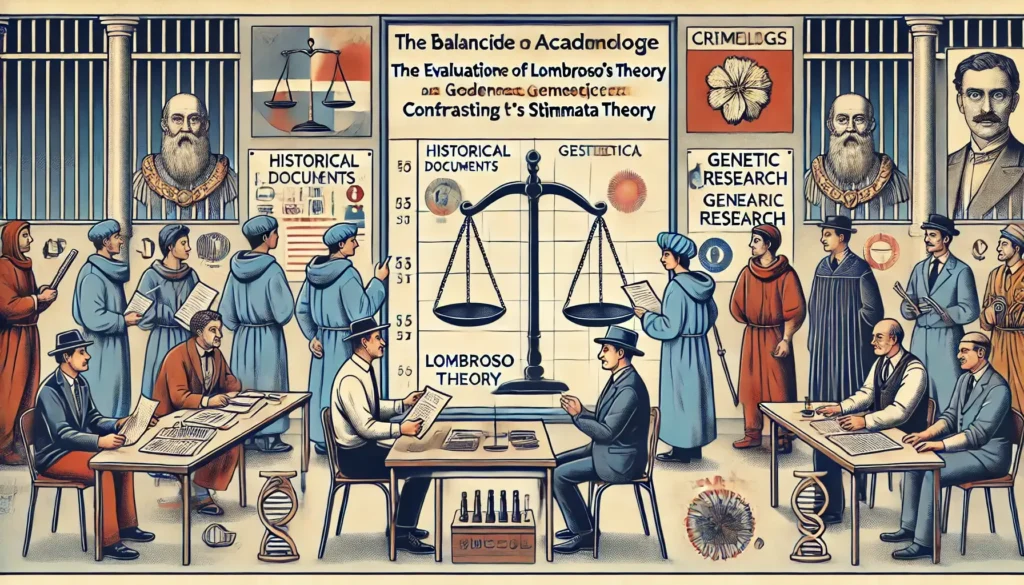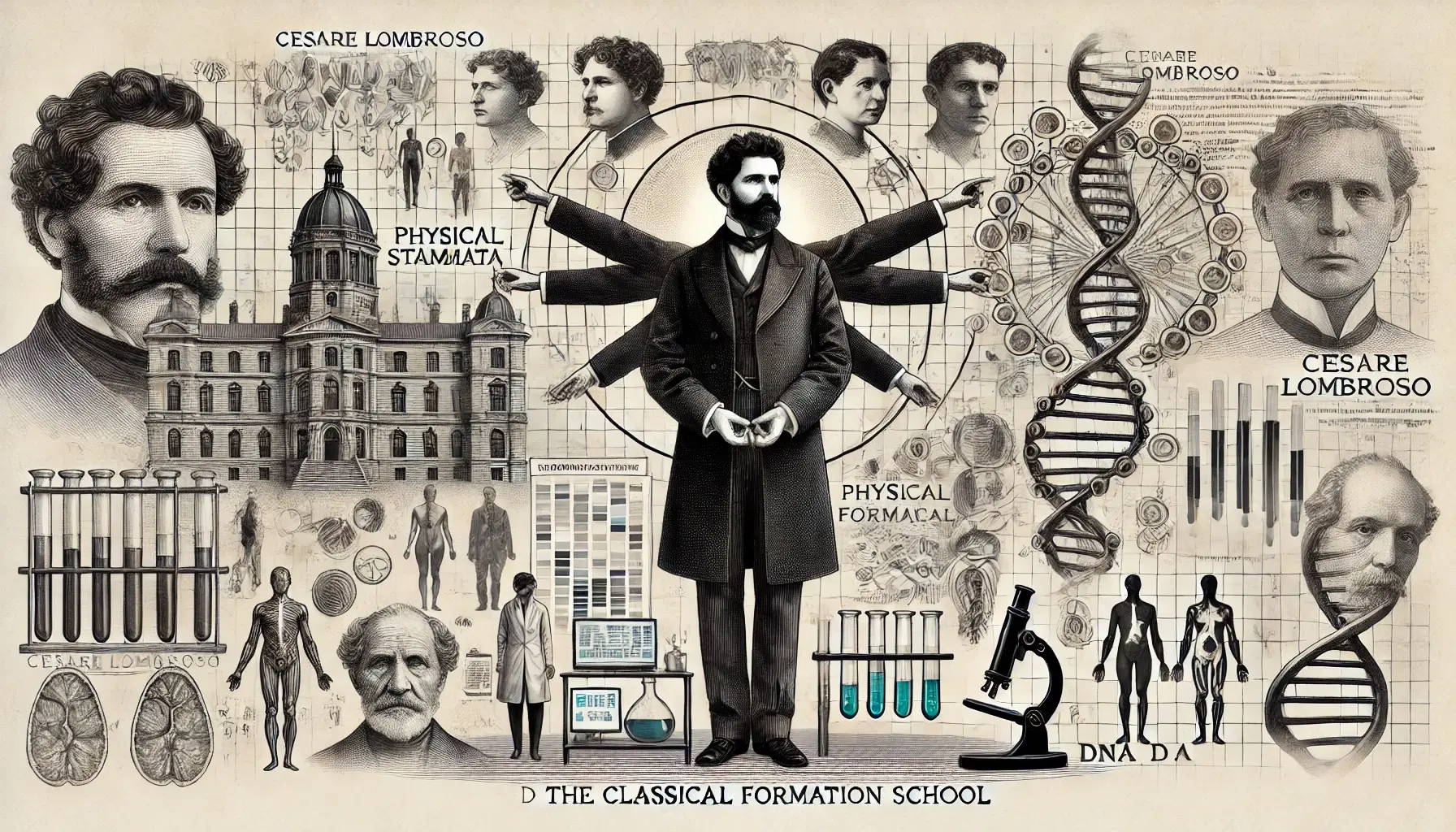Introduction
The Classical Formation School of criminology marks a significant turning point in understanding crime and criminal behavior. Among its most influential contributors was Cesare Lombroso, an Italian physician and criminologist whose theories profoundly shaped the early development of the field. Lombroso introduced the idea that criminality was biologically determined, challenging the classical view that crime was a matter of rational choice. His theory, often referred to as the “Born Criminal” theory, laid the groundwork for subsequent biological approaches to criminology.
This article delves into Lombroso’s theory, exploring its core tenets, scientific methodologies, and historical context. Furthermore, it critically evaluates the strengths and weaknesses of his work, offering insight into its enduring influence and the controversies it sparked within criminological studies.
Lombroso’s Theory: An Overview
Background and Context
Lombroso’s theory emerged during the late 19th century, a period marked by rapid advancements in science and medicine. Influenced by Darwinian evolution and contemporary medical practices, Lombroso sought to apply scientific principles to the study of crime. His work was motivated by a desire to identify the root causes of criminal behavior, which he believed could be traced to innate biological factors.
Core Tenets of Lombroso’s Theory
Lombroso’s theory revolved around the concept of the “Born Criminal,” suggesting that some individuals were predisposed to criminality due to inherited traits. The primary elements of his theory include:
- Atavism Lombroso proposed that criminals represented a regression to an earlier evolutionary stage. He described them as “atavistic” beings, possessing physical and psychological traits reminiscent of primitive humans. These traits, he argued, made them naturally inclined toward deviant behavior.
- Physical Stigmata According to Lombroso, criminals could be identified by specific physical characteristics or “stigmata,” such as:
- Asymmetrical facial features.
- Large jaws or protruding ears.
- Long arms relative to body size.
- High cheekbones and thick eyebrows.
- Types of Criminals Lombroso categorized criminals into several types based on their characteristics and behaviors:
- Born Criminals: Individuals with inherent biological traits predisposing them to crime.
- Occasional Criminals: Those who commit crimes due to environmental factors or circumstances.
- Criminals by Passion: Individuals driven by intense emotions or impulses.
- Methodology and Observations Lombroso’s conclusions were derived from extensive studies of prisoners and their physical features. He conducted autopsies and examined skull shapes, body structures, and other physical attributes, seeking correlations with criminal behavior. His book, L’Uomo Delinquente (The Criminal Man), published in 1876, compiled his findings and became a cornerstone of criminological literature.

Evaluation of Lombroso’s Theory
Contributions and Strengths
Despite its controversies, Lombroso’s theory brought several notable contributions to criminology:
- Foundation for Scientific Criminology Lombroso’s emphasis on empirical research marked a departure from philosophical and moralistic approaches to crime. His work established criminology as a scientific discipline, encouraging systematic observation and analysis.
- Integration of Biological Perspectives By linking criminal behavior to biological factors, Lombroso broadened the scope of criminology. His work paved the way for subsequent studies on genetics, neurology, and psychology in understanding crime.
- Stimulating Debate and Research Lombroso’s theory provoked widespread discussion and critique, inspiring further research into the causes of criminal behavior. His ideas challenged traditional notions of free will and moral responsibility, prompting a reevaluation of legal and penal systems.
- Impact on Criminal Profiling Although flawed, Lombroso’s focus on identifying physical traits associated with crime influenced the development of criminal profiling techniques used in modern law enforcement.
Criticisms and Limitations
Lombroso’s theory has faced significant criticism over the years, particularly regarding its scientific validity and ethical implications:
- Methodological Flaws
- Lombroso’s studies were often based on small, unrepresentative samples, leading to biased conclusions.
- His reliance on physical stigmata as indicators of criminality lacked rigorous scientific evidence.
- Determinism and Reductionism
- The theory’s deterministic nature ignored the role of environmental, social, and cultural factors in shaping behavior.
- It reduced complex human actions to simplistic biological explanations, failing to account for individual agency and choice.
- Ethical Concerns
- Lombroso’s ideas were criticized for perpetuating stereotypes and stigmatization, particularly against marginalized groups.
- The focus on physical traits as markers of criminality risked reinforcing discriminatory practices in law enforcement and justice systems.
- Modern Scientific Reassessment
- Advances in genetics and neuroscience have debunked many of Lombroso’s claims, highlighting the interplay of biological, psychological, and social factors in criminal behavior.
- Studies have shown that physical features are not reliable predictors of criminal tendencies, undermining the validity of Lombroso’s “stigmata” concept.
Enduring Influence and Legacy
Despite its flaws, Lombroso’s theory remains a foundational element of criminological thought. It serves as a historical milestone, illustrating the evolution of ideas about crime and human behavior. Modern criminology has built upon and moved beyond Lombroso’s work, integrating interdisciplinary approaches to address the complexities of criminality.

Conclusion
Cesare Lombroso’s theory within the Classical Formation School represents both a pioneering and contentious chapter in criminology. His emphasis on biological determinants of crime challenged conventional wisdom, sparking debates that continue to influence the field. While his ideas have been largely discredited, their historical significance cannot be understated. Lombroso’s work underscores the importance of scientific inquiry in understanding crime, even as it highlights the need for rigorous methodology and ethical consideration in criminological research.
As criminology evolves, the lessons learned from Lombroso’s contributions and the critiques of his theory remain invaluable. They remind us that the study of crime must embrace complexity, integrating biological, psychological, and sociological perspectives to develop a comprehensive understanding of human behavior.

